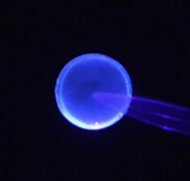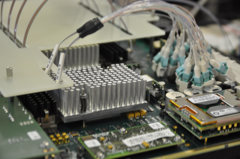Welcome to the program of the ETAP working group for the Institutstreff 2022 on the 8th July 2022 from 10-12am. You can also have a look at the German version🇩🇪.
Details to each event can be found below.
Please pre-register under doodle schedule, because especially lab tour are limited to a certain number of visitors. Time and meeting point is also described below. Confirmations or cancellations will be sent by e-mail.
| Time | Lab tours | Talks | ||
| 10am | Particle trap | Particle detectors | ||
| 10:30 | Scintillators | Optical sensors | FPGAs | Neutrino mass |
| 11am | Particle trap | W mass | ||
| 11:30 | Scintillators | Optical sensors | FPGAs | Neutrino mass |
Lab tours
Scintillator-Lab (WG Wurm) [Scintillators]
 Scintillators are widely used as light-producing detection media in modern particle-physics experiments. The applications range from the cm-scale plastic scintillator tiles of the CALICE calorimeter to the 20,000 ton liquid-scintillator target of the JUNO neutrino experiment. The lab tour will show the most recent developments in organic, opaque and water-based scintillators of our Mainz laboratory as well as the table-top instruments that we use to determine light yield, fluorescence properties and light transparency.
Scintillators are widely used as light-producing detection media in modern particle-physics experiments. The applications range from the cm-scale plastic scintillator tiles of the CALICE calorimeter to the 20,000 ton liquid-scintillator target of the JUNO neutrino experiment. The lab tour will show the most recent developments in organic, opaque and water-based scintillators of our Mainz laboratory as well as the table-top instruments that we use to determine light yield, fluorescence properties and light transparency.
at 10.30 und 11.30, max. 6 people per event
meeting point in front of the elevators 5th floor (Staudingerweg 7)
High Speed Electronics Lab (WGs Büscher/Tapprogge) [FPGAs]
Particle detectors for collider experiments generate huge amounts of data that need to be reduced in real time before they can be stored permanently. For this purpose, dedicated high-density and ultra-fast electronics are being developed and built in Mainz, which can process data in real time and make filter decisions with the help of programmable logic components (FPGAs). The modules can process up to 3 Tbit/s with massively parallel algorithms. In the laboratory tour, we show the construction, operation and testing of these modules on site and report on the installation and commissioning that has just taken place in the ATLAS experiment in Geneva.¹
at 10.30 und 11.30, max. 6 people per event
meeting point in front of office 04-433 (Staudingerweg 7)
Lonely, cold atoms for neutrino mass [Particle trap]
In this project, AG Fertl and AG Böser are investigating methods for efficient production and cooling mechanisms for an intense beam of atomic hydrogen. This serves as a starting point for a future neutrino mass experiment based on ultracold atomic tritium in an atom trap. The energy of the the decay electrons is thereby determined via the novel method of cyclotron radiation spectroscopy.
at 10am und 11am, max. 6 people per event
meeting point in front of lab 05-528 (Staudingerweg 7)
Optical sensors for the South Pole: detector development for extensions of the IceCube experiment [Optical sensors]
IceCube consists of 5160 light sensors distributed over 1km3 of deep glacial ice at the geographic South Pole, which can time-stamp the arrival time of individual photons. Through this instrumentation, the ice block acts as a telescope for exotic elementary particles (especially neutrinos) generated in the highest energy processes of the universe.
For a detector extension, which is to be inserted into the ice in 2025/26, the AG Böser is developing novel light sensors, which greatly increase the collection area by exploiting wavelength-shifting color compared to the commonly used photomultipliers.
at 10.30 und 11.30, max. 6 people per event
meeting point in front of lab 05-526 (Staudingerweg 7)
Talks
Discovery of new physics: Is the W boson really too heavy? [W mass]
The determination of the mass of the W boson at the CDF experiment has attracted a great deal of attention in recent weeks, as a deviation of more than 7 sigma from the expectation of the Standard Model of particle physics was observed. However, this measurement also contradicts a measurement from 2016, which was carried out under the leadership of ETAP. In a short lecture we will classify the new measurement and try to explain whether there is really an indication of new physics.¹
at 11am, max. 15 people
ETAP seminar room (04-225, Staudingerweg 7)
"Microscopes" for elementary particles [Particle detectors]
Our eyes constantly supply the brain with so much information that most of it has to be filtered out immediately. The small fraction of it that we consciously perceive is what we call "seeing". However, human eyes are only sensitive to sunlight and have a limited resolution. Optical microscopes can be used to see cells of animals and plants, as well as bacteria. To get further, the wave-particle duality can be exploited: very light, very fast particles have an extremely short wavelength. Electron microscopes are based on this principle. If one wants to study the smallest constituents of matter (the elementary particles), as is the case at the 27-km-long Large Hadron Collider at CERN near Geneva, one needs detectors that weigh thousands of tons and are as large as a 12-story building.
at 10am, max. 15 people
ETAP seminar room (04-225, Staudingerweg 7)
Unfathomable Neutrinos: Measuring the ghost particles [Neutrino mass]
How do you actually measure the mass of an elementary particle? And why are the masses of neutrinos still unknown? How come neutrinos can change their "flavor" on their way through the earth? Why does it help to build a detector at the South Pole to make progress in this question? And what does all this have to do with neutrino masses?
We want to pursue all these questions in this lecture, which is not only addressed to physicists.
at 10:30 and 11:30, max. 15 people
ETAP seminar room (04-225, Staudingerweg 7)
¹Abstract has been translated automatically


